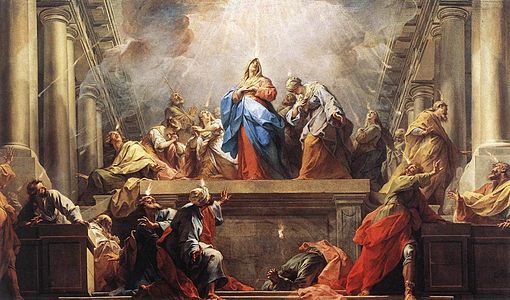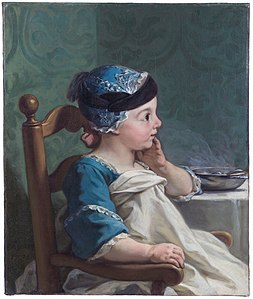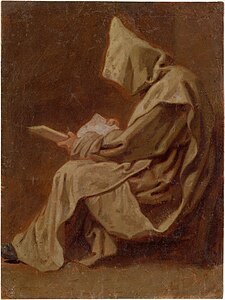| Jean Restout the Younger | |
|---|---|
| Jean Restout le Jeune | |
 Portrait by Tadeusz Kuntze after Maurice Quentin de La Tour, 1756 Portrait by Tadeusz Kuntze after Maurice Quentin de La Tour, 1756 | |
| Born | 26 March 1692 Rouen, Kingdom of France |
| Died | 1 January 1768 (aged 75) Paris, Kingdom of France |
| Education | Jean Restout the Elder, Jean Jouvenet |
| Spouse | Marie-Anne Halli |
| Children | Jean-Bernard Restout |
| Parents |
|
| Family | Restout |
| Director of the Académie Royale de Peinture et de Sculpture | |
| In office 1760–1763 | |
| Monarch | Louis XV |
| Preceded by | Louis de Silvestre |
| Succeeded by | Jacques Dumont le Romain |
Jean Restout the Younger (26 March 1692 – 1 January 1768) was a French artist, who worked in painting and drawing. Although little remembered today, Restout was well-respected by his contemporaries for his religious compositions.
Biography
Restout was born in the city of Rouen in Normandy on 26 March 1692. He was a son and pupil of Jean Restout the Elder, a church painter from Caen. His mother, Marie Madeleine Jouvenet (c. 1655 – before 1729), was also an artist and a sister of the famed painter Jean Jouvenet.
Jean Restout the Elder died suddenly in 1702 and thereafter two of his brothers, the artists Jacques and Eustache, cared for the ten-year-old Restout. In 1707, following their introduction to one another by Eustache, Restout entered Jouvenet's studio in Paris. He rose to a position of some importance while there, even assisting his uncle in the completion of his last commissions. Furthermore, Jouvenet gave Restout the majority of his many drawings, a number of which were figure studies.
On 29 May 1717, Restout was admitted to the Académie Royale de Peinture et de Sculpture as an agréé or associate following his submission of the painting Venus Ordering Arms from Vulcan for Aeneas. He evidently prepared an additional, complementary work for the Academy entitled Venus Presenting Arms to Aeneas. Both paintings may have been composed in anticipation of that year's Prix de Rome competition, but apparently Restout only thought about entering the contest as he was not among the April finalists.
Restout's career as a religious painter began in earnest in 1730, when he received a dual commission from the Benedictine abbey at Bourgueil near Chinon. Both paintings, the Ecstasy of St Benedict and the Death of St. Scholastica, center around monastic figures.
In 1729, Restout married Marie-Anne Hallé (1704–1784), daughter of Academy painter Claude-Guy Hallé. In 1732, she gave birth to their only child, Jean-Bernard Restout. He, like his father, had a successful, though rather conventional, painting career: he won the Prix de Rome in 1758, was admitted to the Academy in 1769, and exhibited regularly at the Paris Salon.
Restout died in the Louvre Palace on 1 January 1768. His late baroque classicism rendered his altarpieces, such as the Death of St. Scholastica an isolated achievement that ran counter to his rococo contemporaries.
Selected works
- Saint Bruno in Prayer (1711) – Musée des Beaux-Arts de Dole.
- Portrait of Dom Louis Daudouin du Basset, a Carthusian monk of Gaillon (1716) – Musée des Beaux-Arts de Rouen.
- Venus Ordering Arms from Vulcan for Aeneas (1717) – Los Angeles County Museum of Art.
- Venus Presenting Arms to Aeneas (1717) – Ottawa, National Gallery of Canada.
- Alpheus and Arethusa (1720) – Musée des Beaux-Arts de Rouen.
- Ecstasy of St Benedict (1730) – Musée des Beaux-Arts de Tours.
- Death of St Scholastica (1730) – Musée des Beaux-Arts de Tours.
- Alexander and his Doctor (1747) – Musée de Picardie, Amiens.
- Martyrdom of St. Andrew (1749) – Musée de Grenoble.
- Triumph of Bacchus and Ariadne (1757) – Sanssouci, Potsdam.
- Orpheus and Eurydice (1763) – Musée des Beaux-Arts de Rennes.
Gallery
Paintings
-
 Saint Bruno in Prayer (1711)
Saint Bruno in Prayer (1711)
-
 Venus Ordering Arms from Vulcan for Aeneas (1717)
Venus Ordering Arms from Vulcan for Aeneas (1717)
-
 Alpheus and Arethusa (1720)
Alpheus and Arethusa (1720)
-
 Death of St Scholastica (1730)
Death of St Scholastica (1730)
-
 Pentecost (1732)
Pentecost (1732)
-
 Boy in a Child's Chair or Portrait de Jean-Bernard Restout (1736)
Boy in a Child's Chair or Portrait de Jean-Bernard Restout (1736)
-
 Martyrdom of St. Andrew (1749)
Martyrdom of St. Andrew (1749)
-
 Triumph of Bacchus and Ariadne (1757)
Triumph of Bacchus and Ariadne (1757)
Drawings
-
 Seated Carthusian Holding an Open Book (1711)
Seated Carthusian Holding an Open Book (1711)
-
 Head of a Bearded Man (c. 1750)
Head of a Bearded Man (c. 1750)
-
 Funeral of François Duplessis de Mornay
Funeral of François Duplessis de Mornay
Notes and references
Notes
- Also known as Jean II Restout or Jean Restout II
References
- Conisbee, Philip (2003). "Restout, Jean, II". Grove Art Online. Oxford University Press. Retrieved 1 August 2023.
- "Restout, Jean, the Elder". Benezit Dictionary of Artists. Oxford University Press. 2011. doi:10.1093/benz/9780199773787.article.B00151317. ISBN 978-0-19-977378-7. Retrieved 1 August 2023.
- "Jouvenet, Marie Madeleine". Benezit Dictionary of Artists. Oxford University Press. 2011. doi:10.1093/benz/9780199773787.article.B00096118. ISBN 978-0-19-977378-7. Retrieved 1 August 2023.
- Pinette, Matthieu (2000). From the Sun King to the Royal Twilight : Painting in Eighteenth-Century France from the Musée de Picardie, Amiens. New York: American Federation of Arts. pp. 76–77. ISBN 1885444133. Retrieved 1 August 2023.
- Goodman, John (1995). "Jansenism, Parlementaire Politics, and Dissidence in the Art World of Eighteenth-Century Paris: The Case of the Restout Family". Oxford Art Journal. 18 (1): 74–95. doi:10.1093/oxartj/18.1.74.
- Schnapper, Antoine (Summer 1967). "'Les Compositions' of Jean Jouvenet". Master Drawings. 5 (2): 135–143, 199–208.
- Restout, Jean-Bernard; Cochin, Charles-Nicolas, eds. (1771). "Restout". Galerie françoise, ou Portraits des hommes et des femmes célèbres qui ont paru en France (in French). Vol. II. Paris: Jean-Thomas Hérissant (a.k.a. Herissant le fils), printer-bookseller. Retrieved 2 August 2023.
- "Restout, Jean, the Younger". Benezit Dictionary of Artists. Oxford University Press. 2011. doi:10.1093/benz/9780199773787.article.B00151318. ISBN 978-0-19-977378-7. Retrieved 1 August 2023.
- Rosenberg, Pierre; Schnapper, Antoine (1982–1983). "Paintings by Restout on Mythological and Historical Themes: Acquisition by the National Gallery of Canada of Venus Presenting Arms to Aeneas". Annual Bulletin of the National Gallery of Canada. 6: 43–54. ISSN 0711-2866.
- Guiffrey, Jules; Barthélemy, Joseph, eds. (1908). Liste des pensionnaires de l'Académie de France à Rome de 1663 à 1907 (in French). Paris: Firmin-Didot. p. 23.
- Conisbee, Philip (1981). Painting in Eighteenth-Century France. Oxford: Phaidon Press. pp. 52–54. ISBN 0-7148-2147-0. Retrieved 4 August 2023.
- Join-Lambert, Sophie (2008). "L'Extase de saint Benoît". mba.tours.fr (in French). Retrieved 4 August 2023.
- Join-Lambert, Sophie (2008). "La Mort de sainte Scholastique". mba.tours.fr (in French). Retrieved 4 August 2023.
- Estournet, O. (1905). La Famille des Hallé (in French). Réunion des Sociétés des beaux-arts des départements. pp. 47–50.
- Turner, S. J. (2003). "Restout, Jean-Bernard". Grove Art Online. Oxford University Press. Retrieved 4 August 2023.
- Levey, Michael (1985). Rococo to Revolution : Major Trends in Eighteenth-Century Painting. Thames and Hudson. p. 36. ISBN 978-0-500-20050-6. Retrieved 4 August 2023.
- Marandel, J. Patrice (2011). "Venus Ordering Arms from Vulcan for Aeneas". collections.lacma.org. Los Angeles County Museum of Art. Retrieved 2 August 2023.
- "Venus Presenting Arms to Aeneas". gallery.ca. National Gallery of Canada. Retrieved 2 August 2023.
- "Jean Restout, "Alexandre malade recevant le breuvage du médecin Philippe"". amiens.fr (in French). Retrieved 3 August 2023.
Further reading
- Réau, Louis; Messelet, Jean; Adhémar, Jean (1938). "Carle Vanloo, Jean Restout: Les lithographies de paysages en France à l'époque romantique". Nouvelles archives de l'art français (in French). Vol. 19. Société de l'histoire de l'art français.
- Rosenberg, Pierre; Schnapper, Antoine (1970). Jean Restout (1692–1768) : Musée des Beaux-Arts de Rouen, Juin-Septembre 1970 (in French). Rouen: Musée des Beaux-Arts de Rouen. OCLC 489634124.
- Gouzi, Christine (2000). Jean Restout, 1692–1768 : Peintre d'histoire à Paris (in French). Paris: Arthena. ISBN 9782903239275. OCLC 46462444.
- Gouzi, Christine (2013). Jean Restout et les miracles de Saint-Médard (in French). Montigny-le-Bretonneux: Yvelinedition. ISBN 9782846684491. OCLC 894848499.
External links
 Media related to Jean II Restout at Wikimedia Commons
Media related to Jean II Restout at Wikimedia Commons
| Académie Royale de Peinture et de Sculpture | |
|---|---|
| Founding anciens (elders) | |
| Founding académistes (academicians) |
|
| Directeurs of the Académie |
|
| Related Institutions | |